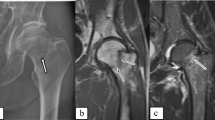Abstract
While the displaced hip fracture can be visualized easily by plain radiography, the non-displaced fracture may be radiographically occult and require different imaging modalities, e.g., MRI for proper visualization. The accuracy of readers and cost advantages of utilizing MRI have not been assessed. Therefore, we undertook a study of these factors. The medical records of all patients who had visited the emergency room from June 2002 until May 2003 with a clinically suspected hip fracture, negative or equivocal plain film and subsequent MRI examination were retrospectively reviewed. Two senior and two junior radiologists independently evaluated both the MR images and radiographs of all 33 patients in a blinded study. One of three possible evaluations was described for the images of each modality: absence, presence or possibility of fracture. The economic consequences of using MRI in the detection of occult hip fractures were calculated. For all four doctors participating in this study, MRI proved to be far more sensitive and specific in the detection of occult hip fractures than radiography. Using the MR images, the senior radiologists identified the occult hip fracture patients with 100% accuracy and were in complete agreement. The agreement between junior and senior radiologists was high (average κ=0.75). MRI also detected soft tissue injuries in 39% of the patients that could not be identified with radiography. Adoption of the new protocol using MRI saves hospitals from €242 to 627 per patient. By shortening the time to diagnosis and permitting a superior visualization of both bone and soft tissue injuries, MR imaging prevents unnecessary hospitalization and delays in definitive treatment. MR images should be assessed by senior radiologists.




Similar content being viewed by others
References
Marks R, Allegrante JP, MacKenzie CR, Lane JM (2003) Hip fractures among the elderly: causes, consequences and control. Ageing Res Rev 2:57–93
Cooper C, Campion G, Melton LJ (1992) Hip fractures in the elderly: a worldwide projection. Osteoporosis Int 2:285–289
Cummings SR, Melton LJ (2002) Epidemiology and outcomes of osteoporotic fractures. Lancet 359:1761–1767
Melton LJ (1993) Hip fractures: a worldwide problem today and tomorrow. Bone 14:51–58
Zukerman JD (1996) Hip fracture. N Engl J Med 334:1519–1525
Wolinsky FD, Fitzgerald JF, Stump TE (1997) The effect of hip fracture on mortality, hospitalization, and functional status: a prospective study. Am J Public Health 87:398–403
Cooper C (1997) The crippling consequences of fractures and their impact on quality of life. Am J Med 103(Part A):12S–19S
Feldman D, Zuckerman JD, Frankel VH (1990) Geriatric hip fractures: preoperative decision making. J Musculoskelet Med 7:69–78
Parker MJ (1992) Missed hip fractures Arch Emerg Med 9:23–27
Rizzo PF, Gould ES, Lyden IP et al (1993) Diagnosis of occult fractures about the hip. J Bone Joint Surg Am 75:395–401
Perron AD, Miller MD, Brady WJ (2002) Orthopedic pitfalls in the ED: radiographically occult hip fracture. Am J Emerg Med 20:234–237
Lim KB, Eng AK, Chng SM, Tan AG, Thoo FL, Low CO (2002) Limited magnetic resonance imaging (MRI) and the occult hip fracture. Ann Acad Med Singapore 5:607–610
Guanche CA, Kozin SH, Levy AS, Brody LA (1994) The use of MRI in the diagnosis of occult hip fractures in the elderly: a preliminary review. Orthopedics 17:327–330
Bogost GA, Lizerbram EK, Crues JV III (1995) MR imaging in evaluation of suspected hip fracture: frequency of unsuspected bone and soft-tissue injury. Radiology 197:263–267
Kiuru MJ, Pihlajamaki HK, Ahovuo JA (2003) Fatique stress injuries of the pelvic bones and proximal femur. Evaluation with MR imaging. Eur Radiol 13:605–611
Milnek E, Clark CK., Walker CW (1998) Limited magnetic resonance imaging in the diagnosis of occult hip fractures. Am J Emerg Med 16:390–392
Rubin SJ, Marquardt JD, Gottlieb RH et al (1998) Magnetic resonance imaging: a cost-effective to bone scintigraphy in the evaluation of the patients with suspected hip fractures. Skeletal Radiol 27:199–204
Kiru MJ, Pihlajamaki HK, Hietanen HJ, Ahovuo JA (2002) MR imaging, bone scintigraphy, and radiography in bone stress injuries of the pelvis and the lower extremity. Acta Radiol 43:207–212
Danish Health Authorities (2002) DRG. www.sst.dk
Acknowledgement
The authors thank the Statistics Department at the University of Toronto for assistance.
Author information
Authors and Affiliations
Corresponding author
Rights and permissions
About this article
Cite this article
Verbeeten, K.M., Hermann, K.L., Hasselqvist, M. et al. The advantages of MRI in the detection of occult hip fractures. Eur Radiol 15, 165–169 (2005). https://doi.org/10.1007/s00330-004-2421-2
Received:
Revised:
Accepted:
Published:
Issue Date:
DOI: https://doi.org/10.1007/s00330-004-2421-2




